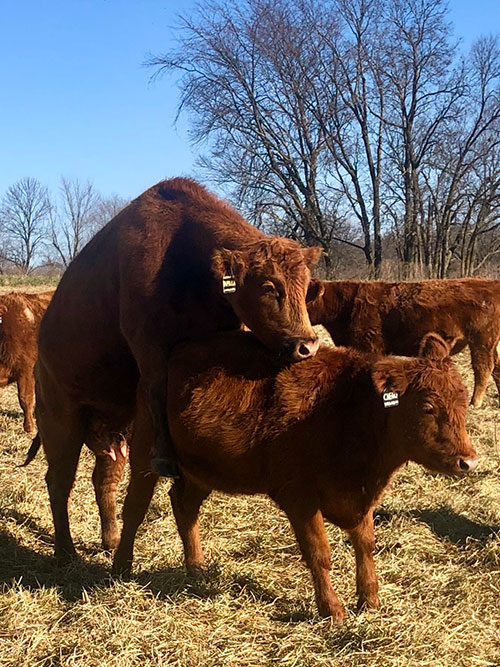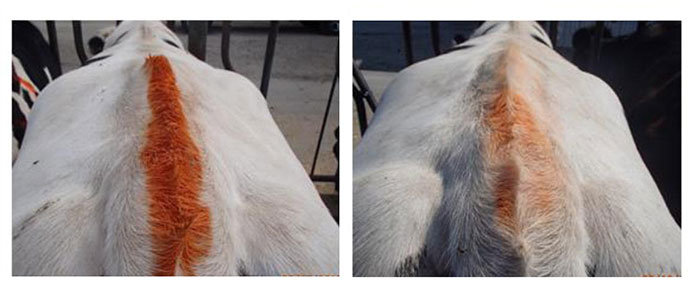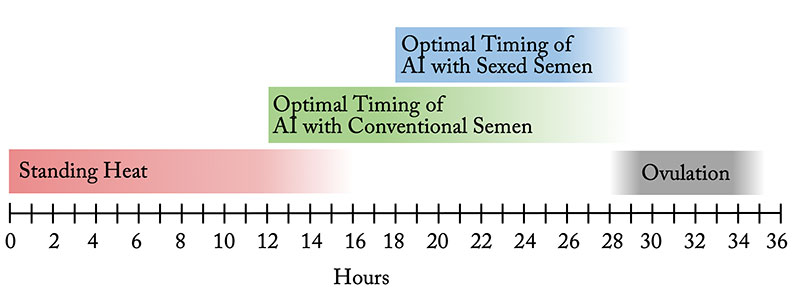Correctly detecting cows and heifers in estrus can be critical depending on how artificial insemination or embryo transfer is managed. Estrus, or standing heat, is the sexually receptive period of a cow’s reproductive cycle that occurs just prior to ovulation. Behavioral and physiological changes can be observed to determine when a cycling cow is in estrus, which occurs every 17 to 24 days depending on length of the cow’s estrous cycle.
Physiology of estrus and ovulation
Estrus occurs for an average of duration of 18 hours in cattle, although duration of estrus is widely varied from female to female and can range from 8 to 24 hours in length. Estrus behavior stems from a rise in estradiol, or estrogen, produced by the preovulatory follicle. Shortly after the onset of estrus, a surge of luteinizing hormone, or LH, is released by the pituitary gland. This initiates the cascade of events leading up to ovulation, which occurs approximately 30 hours after the onset of estrus.
Estrus is not always accompanied by ovulation, nor is ovulation always accompanied by estrus. Standing heat without ovulation (anovulatory estrus) will not result in pregnancy even though the female may be serviced. Ovulation without behavioral estrus (silent heat) is not uncommon in cows, especially the first few weeks after calving. Such females will not accept service from a male, but artificial insemination can result in pregnancy in some cases if semen is placed at the appropriate time in advance of ovulation.
For the vast majority of cows, the high serum concentrations of progesterone result in suppression of estrus behavior and ovulation during pregnancy. However, a small percentage of pregnant females may continue to show signs of estrus throughout pregnancy, so return to estrus cannot be considered a definitive sign of non-pregnant status. For information on confirmation of pregnancy status, see MU Extension publication G2042, Determination of Pregnancy Status in Beef Cattle Herds.

Signs of estrus
The primary sign of estrus is when a female stands to be mounted by a bull or by another female (Figure 1). Hence, estrus is often referred to as “standing heat.” Length of standing estrus among cattle is highly variable, but ovulation occurs approximately 30 hours after the start of standing heat behavior. The goal of a good heat detection program is to accurately determine if and when a cow or heifer has exhibited standing heat before she is inseminated.
Other secondary signs of estrus are useful when observing a group of females. Secondary signs of estrus do not definitively indicate that a female is in estrus; however, secondary signs may help to identify females that should be monitored closely. There may be increased activity, vocalization, and nervousness starting anywhere from 4 to 48 hours before standing estrus. The vulva will often be slightly swollen, and there may be long clear streams of vaginal mucus visible as it is discharged from the vulva. Females nearing onset of heat may also be more likely to mount or attempt to mount other females in heat. Females that mount a few times and then drift off are probably not in heat, but a female that continues to make repeated attempts to mount may be coming into standing heat soon and should monitored for future willingness to stand when mounted.
Estrus detection aids
Even with proper observation and an experienced eye for detection of estrus, it is difficult to witness every female in standing estrus. There are many tools available to aid in estrus detection.
Tail chalking

The least expensive method is to mark the tailhead with paint or marking chalk (Figure 2). When the female stands to be mounted, the paint or chalk is rubbed off. The paint needs to be reapplied daily, and it may take some experience to correctly interpret if the paint was rubbed off by mounting or for some other reason. Tail chalking works well in a dairy system where females are brought in multiple times a day to be milked and it is easier to observe and reapply paint as needed. It does not work as well on a beef operation because the paint can more easily be rubbed off in a pasture setting or washed away by weather.
Chin ball markers

Chin ball markers are large ball-point markers mounted on a halter and worn under the chin of a detector animal. The detector animal may be a vasectomized and/or penile-diverted bull (also known as a gomer bull) or an animal that has been androgenized to increase sexual desire. When the detector animal mounts a female that is in estrus, the chin ball rubs on the back and marks the female (Figure 3). A veterinarian should be consulted to make surgical and medical decisions when creating detector animals.
Mount detectors

One of the most common aids for estrus detection are adhesive patches that are applied on the tailhead. After a female is mounted, the patch will change color to indicate that she is ready to be inseminated. Two popular products are Estrotect Breeding Indicators and Kamar Heatmount Detectors. Estrotect Breeding Indicators have a top gray coating that is rubbed off during mounting to display a bright indicator color underneath. Multiple mounts are required to rub off the top coating. More than half of the top coating should be rubbed off to consider the female to be in standing estrus (Figure 4). Kamar detectors have a pressure sensor that turns bright red once it has been activated. They require three seconds of pressure from the mounting animal to activate. Mount detectors are relatively inexpensive and can improve the accuracy of heat detection, especially if animals are observed only twice daily.
Other methods
Other tools exist for monitoring estrus behavior among cattle, with more continuing to be developed. One technological approach is to use touch-sensitive or pressure-sensitive radiotelemetric or Wi-Fi–based transmitters mounted to the tailhead of the female. Another approach is to use activity-monitoring technologies to determine onset of estrus using algorithms or machine-learning. Finally, continuously monitoring the concentration of progesterone in the milk or serum can also assist in determining estrous status as well as pregnancy status. Due to the cost of these electronic systems or assays, however, these systems are more commonly used in more intensively managed dairy herds or in research settings.
Estrus detection and timing of AI
Ovulation occurs approximately 30 hours after standing estrus can first be observed. For optimal fertility, insemination should be performed in advance of ovulation (Figure 5). This is because sperm cells need time in the female reproductive tract to undergo a process called capacitation in order to successfully fertilize an oocyte. Because of this, timing of insemination in relation to onset of standing estrus is very important. Females should be observed for standing estrus at least twice a day, in the morning and evening. More frequent observation (e.g., dawn, noon, and dusk) is suggested if labor and time allow.
Females that are observed in standing estrus should be inseminated approximately 12 to 18 hours after the start of standing estrus if using conventional semen. When AI is performed following detected estrus, this can be accomplished by following the “AM-PM Rule.” When using the AM-PM rule, females that are observed in estrus in the morning are inseminated that evening, and females that are observed in estrus in the evening are inseminated the following morning.
Note, however, that a slightly later timing of artificial insemination is recommended if using sexed semen, due to the reduced fertile lifespan of sexed semen in the female reproductive tract. If using sexed semen, optimal timing of AI is suggested to be 18 to 24 hours after the start of standing estrus. For more information on use of sexed semen in artificial insemination programs, refer to MU Extension publication G2026, Sexed Semen for Artificial Insemination: Recommendations and AI Approaches.

Summary
A good estrus detection program depends on accurately identifying which animals have stood to be mounted. There are many tools available to aid producers in identifying females in estrus. Cost, labor, and production system should be carefully considered when selecting which tool will work best for each operation. Note also that estrus detection is not necessarily required in order to carry out an AI program. For more information on protocols that facilitate timed artificial insemination, see MU Extension publication G2024, Estrus Synchronization Recommendations for Artificial Insemination of Mature Beef Cows, and MU Extension publication G2025, Estrus Synchronization Recommendations for Artificial Insemination of Beef Heifers.